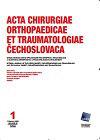肩胛骨韧带部分撕裂;不稳定前泪液定位、韧带损伤相关性和保守治疗反应:横断面研究。
IF 0.4
4区 医学
Q4 ORTHOPEDICS
Acta chirurgiae orthopaedicae et traumatologiae Cechoslovaca
Pub Date : 2023-02-15
DOI:10.55095/achot2023/003
引用次数: 0
摘要
研究目的:舟月骨间韧带(SLIOL)撕裂伴外源性韧带断裂与舟月骨(SL)不稳定有关。从撕裂的定位、等级和伴随的韧带外损伤的角度来检查SLIOL部分撕裂。根据损伤类型仔细检查保守治疗的反应。材料与方法对未分离的SLIOL撕裂患者进行回顾性分析。磁共振(MR)图像重新检查撕裂定位(掌侧、背侧或掌侧和背侧联合撕裂)、损伤等级(部分或完全)和外源韧带损伤伴随(RSC、LRL、STT、DRC、DIC)。用磁共振成像检查损伤的相关性。所有保守治疗的患者在第一年被召回进行重新评估。根据治疗前和治疗后第一年疼痛视觉模拟量表(VAS)、手臂、肩部和手部残疾问卷(DASH)和患者评定腕部评估(PRWE)评分分析保守治疗的反应。结果:在我们的队列中,79% (n: 82/104)的患者有SLIOL撕裂,44% (n: 36)的患者伴有外韧带损伤。大部分的韧带撕裂和所有的韧带外源性损伤都是部分撕裂。在SLIOL损伤中,掌侧SLIOL是最常见的损伤部位(45%,n: 37)。DIC (n: 17)和LRL (n: 13)是最常见的撕裂韧带,桡肱三端韧带(LRL)损伤通常与掌侧撕裂并存,而背侧腕间韧带(DIC)与背侧撕裂无关。与孤立的SLIOL撕裂相比,外源性韧带损伤伴发的治疗前VAS、DASH和PRWE评分较高。损伤等级、部位和外源性韧带伴发对治疗效果无显著影响。在急性损伤中,测试成绩逆转效果更好。结论对SLIOL损伤进行影像学检查时,应注意二级稳定剂的完整性。在部分SLIOL损伤中,保守治疗可以减轻疼痛和功能恢复。如果二级稳定剂完好无损,保守入路可以作为局部损伤的初始治疗选择,特别是在急性病例中,无论撕裂定位和损伤等级如何。关键词:舟月骨间韧带,外源性腕韧带,腕不稳定,腕MRI,腕韧带损伤,舟月骨掌背韧带。本文章由计算机程序翻译,如有差异,请以英文原文为准。
Scapholunate Ligament Partial Tears; Tear Localization, Extrinsic Ligament Injury Association and Conservative Treatment Responses Prior to Instability: Cross-Sectional Study.
PURPOSE OF THE STUDY Scapholunate interosseous ligament (SLIOL) tears with accompanying extrinsic ligament rupture have been associated with scapholunate (SL) instability. SLIOL partial tears were examined in terms of tear localization, grade and accompanying extrinsic ligament injury. Conservative treatment responses were scrutinized according to injury types. MATERIAL AND METHODS Patients with SLIOL tear without dissociation were evaluated retrospectively. Magnetic resonance (MR) images were reexamined in terms of tear localization (volar, dorsal or combined volar and dorsal tears), grade of injury (partial or complete) and extrinsic ligament injury accompaniment (RSC, LRL, STT, DRC, DIC). Injury associations were examined with MR imaging. All patients treated conservatively were recalled at their first year for re-evaluation. Conservative treatment responses were analyzed according to pre- and post-treatment first year visual analog scale for pain (VAS), disabilities of the arm, shoulder and hand questionnaire (DASH) and Patient-Rated Wrist Evaluation (PRWE) scores. RESULTS In our cohort, 79% (n: 82/104) of patients had SLIOL tear and 44% (n: 36) of them had accompanying extrinsic ligament injury. The majority of SLIOL tears and all extrinsic ligament injuries were partial tears. In SLIOL injuries, volar SLIOL was most commonly damaged portion (45%, n: 37). DIC (n: 17) and LRL (n: 13) were most frequently torn ligaments, radiolunotriquetral (LRL) injury generally co-existed with volar tears and dorsal intercarpal ligament (DIC) with dorsal tears regardless of injury time. Extrinsic ligament injury accompaniment was associated with higher pre-treatment VAS, DASH and PRWE scores than isolated SLIOL tears. Injury grade, location and extrinsic ligament accompaniment had no significant effect on treatment responses. Test scores reversal was better in acute injuries. CONCLUSIONS On imaging SLIOL injuries, attention should be paid to the integrity of secondary stabilizers. In partial SLIOL injuries, pain reduction and functional recovery can be achieved with conservative treatment. Conservative approach can be the initial treatment option in partial injuries especially in acute cases regardless of tear localization and injury grade if secondary stabilizers are intact. Key words: scapholunate interosseous ligament, extrinsic wrist ligaments, carpal instability, MRI of wrist, wrist ligamentous injury, volar and dorsal scapholunate interosseous ligament.
求助全文
通过发布文献求助,成功后即可免费获取论文全文。
去求助
来源期刊
CiteScore
0.70
自引率
25.00%
发文量
53
期刊介绍:
Editorial Board accepts for publication articles, reports from congresses, fellowships, book reviews, reports concerning activities of orthopaedic and other relating specialised societies, reports on anniversaries of outstanding personalities in orthopaedics and announcements of congresses and symposia being prepared. Articles include original papers, case reports and current concepts reviews and recently also instructional lectures.

 求助内容:
求助内容: 应助结果提醒方式:
应助结果提醒方式:


